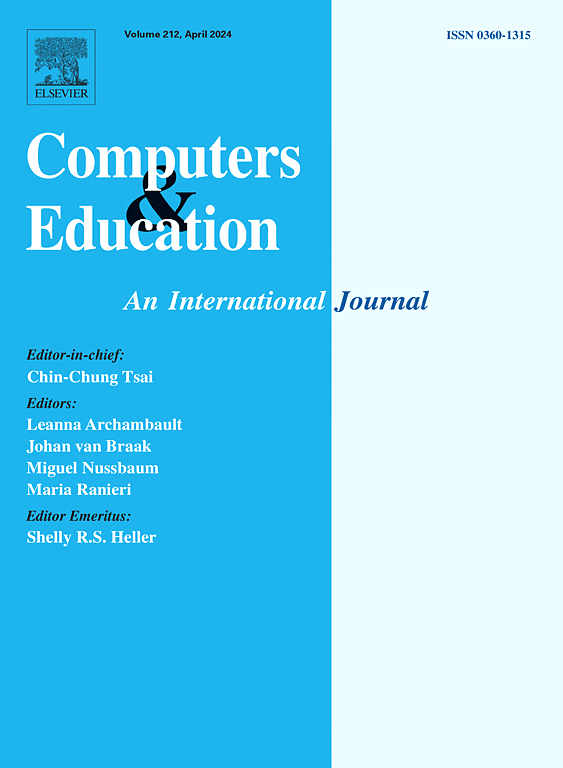Uncovering student profiles. An explainable cluster analysis approach to PISA 2022
IF 10.5
1区 教育学
Q1 COMPUTER SCIENCE, INTERDISCIPLINARY APPLICATIONS
引用次数: 0
Abstract
Educational data mining (EDM) applied to the wealth of data generated from international large-scale assessments (ILSAs) shows potential for identifying successful educational initiatives. Despite limited research on clustering methods in ILSAs, leveraging these methods to uncover student profiles can help decision-making in designing tailored programs. This study aims to identify and characterize 15-year-old student profiles using PISA 2022 data and reveal insights into the relationship between these profiles and factors such as ICT availability and use, gender, academic performance, and educational expectations. We analyzed PISA 2022 Spanish student data (n = 30,800) with a selection of 74 contextual variables, applying an end-to-end explainable cluster analysis methodology that integrates different machine learning (ML) and explainable artificial intelligence (XAI) techniques. This methodology covered data pre-processing, dimensionality reduction, clustering, and classification to ensure data quality and result explainability. We obtained 16 derived variables, 7 student clusters, and an optimal XGBoost classifier with a global accuracy of 0.8643. Using local and global SHAP values, we interpreted clusters, finding that socio-economic status and ICT availability and use at home are the most important factors differentiating student profiles. Our findings suggest the need to emphasize (i) proper ICT accessibility and use, as well as student support networks to improve academic performance, (ii) gender-specific well-being programs, and (iii) the encouragement of educational expectations tailored to students’ gender and their exposure to higher education. These results pave the way for personalized academic policies and programs through ML-based tools for uncovering student profiles.
揭示学生概况。2022 年国际学生评估项目(PISA)的可解释聚类分析方法
将教育数据挖掘(EDM)应用于国际大规模评估(ILSAs)所产生的大量数据,显示出识别成功教育措施的潜力。尽管对国际大规模评估中的聚类方法研究有限,但利用这些方法挖掘学生特征有助于设计量身定制的课程的决策。本研究旨在利用 PISA 2022 数据识别和描述 15 岁学生的特征,并揭示这些特征与信息和通信技术的可用性和使用、性别、学业成绩和教育期望等因素之间的关系。我们分析了 PISA 2022 西班牙学生数据(n = 30,800)和精选的 74 个背景变量,应用了端到端的可解释聚类分析方法,该方法整合了不同的机器学习(ML)和可解释人工智能(XAI)技术。该方法包括数据预处理、降维、聚类和分类,以确保数据质量和结果的可解释性。我们获得了 16 个衍生变量、7 个学生聚类和一个最佳 XGBoost 分类器,其全局准确率为 0.8643。我们利用局部和全局的 SHAP 值对聚类进行了解释,发现社会经济地位和信息与通信技术在家庭中的可用性和使用是区分学生特征的最重要因素。我们的研究结果表明,有必要强调(i)适当获取和使用信息与传播技术,以及学生支持网络,以提高学习成绩,(ii)针对不同性别的福利计划,以及(iii)鼓励根据学生的性别和接受高等教育的情况制定教育期望。这些结果为通过基于 ML 的工具发现学生特征,制定个性化的学术政策和计划铺平了道路。
本文章由计算机程序翻译,如有差异,请以英文原文为准。
求助全文
约1分钟内获得全文
求助全文
来源期刊

Computers & Education
工程技术-计算机:跨学科应用
CiteScore
27.10
自引率
5.80%
发文量
204
审稿时长
42 days
期刊介绍:
Computers & Education seeks to advance understanding of how digital technology can improve education by publishing high-quality research that expands both theory and practice. The journal welcomes research papers exploring the pedagogical applications of digital technology, with a focus broad enough to appeal to the wider education community.
 求助内容:
求助内容: 应助结果提醒方式:
应助结果提醒方式:


